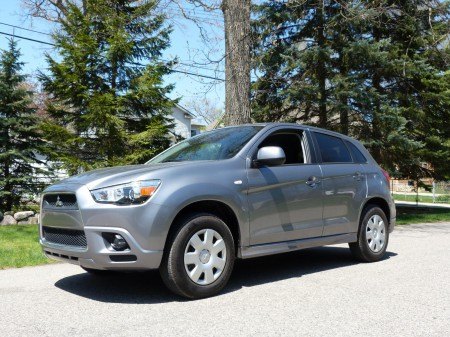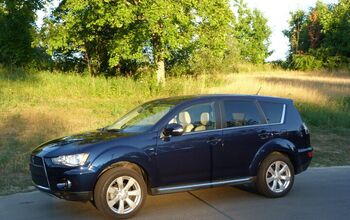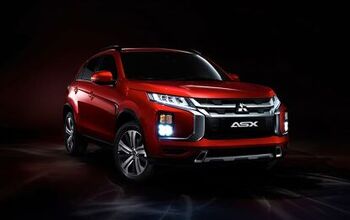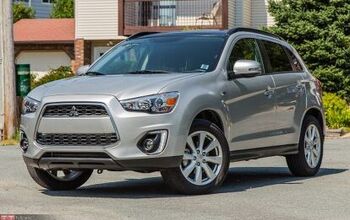Review: 2011 Mitsubishi Outlander Sport
No one out-zombies Mitsubishi. Quite a few manufacturers have had brushes with death, only to bounce back strongly with competitive new cars. For Mitsubishi there’s been no bounce. Yet they’re still alive. Assuming Mitsubishi’s people aren’t actually brain dead, they must be in crisis mode. And cash must be short. So if they employ their scant resources to add a new model, the Outlander Sport, there must be something terribly compelling about it, right? Well, Mitsubishi didn’t exactly swing for the fences. The basic concept behind the Outlander Sport: remove a foot from the rear overhang of the Outlander CUV, cut $3,500 from the base price ($1,000 of it by making a CVT optional), make Bluetooth and USB connectivity standard, and hope the kids bite.
The Outlander Sport’s exterior styling is…different. Severely truncating the tail yields a hatchback profile, but with the ride height and chunkiness of an SUV. (The spirit of AMC lives!) Up front, the Outlander Sport wears the most aggressive grille to ever front a 148-horsepower 2.0-liter four. Mitsubishi has teased about killing the Evo. Perhaps they want to milk any remaining equity before doing so?
Inside the Outlander Sport, Mitsubishi has made some effort to keep pace, with soft-touch surfaces sparingly deployed on the instrument panel and doors. A leather-wrapped steering wheel is standard. But too many parts of the unremittingly black interior seem sourced from the lowest bidder. Some can be excused as having an honest simplicity—they are what they are, with no pretense of being something else—but the large HVAC control knobs, while easy to use, look and feel dreadfully cheap.
Mitsubishis often have a frisky character, and Outlander Sport’s hatchback shape promises sportier driving dynamics than the typical CUV. Hop into the driver seat, and hope immediately starts to fade. The firm front seats are high, and the instrument panel is deep. Even at rest there’s a sense of bulk. The manual shift lever is very tall, effectively communicating that the Outlander Sport aspires to be a truck, not a sporty hatch. A dead pedal is positioned too close. The rear seat is very roomy and comfortably high off the floor, but roomy rear seats are the rule rather than the exception among compact crossovers, so no big win here. Despite the truncated tail there’s a little more cargo space than in the typical compact hatch.
With 148 horsepower motivating 3,000 pounds and the truck-style long throws of the manual shifter, the Outlander Sport isn’t designed for hustling. Around town it gets about plenty well enough, though, and never feels slow. A manual transmission can be worth 20-30 horsepower in perceived acceleration, and this is one such case. If the trip computer can be believed, fuel economy pushes and occasionally even tops 30 in suburban driving. The EPA, using different methodology, reports 24 city, 31 highway.
The major disappointment arrives upon turning the steering wheel. For a 3,000-pound, 169-inch-long vehicle, the Outlander Sport feels surprisingly large and heavy, even clumsy. The tires no doubt deserve a fair amount of the blame. The manual transmission is offered only in the base model, and this model is shod with 215/70HR16 Yokohama Geolander G033s. With a design that optimizes something other than handling (what I don’t know), these tires feel squishy and roll over onto their tall sidewalls with little provocation. The steering has a dead zone on-center, and feels slow and numb. Despite these handicaps, the handling retains a basic competence—there’s a good chassis somewhere in there. With credit due the tall sidewalls, the Outlander Sport usually rides smoothly and quietly, though the tires clomp a bit loudly and reactions to tar strips and expansion joints can be abrupt.
The base Outlander Sport ES lists for only $19,275, which is lower, even much lower, than any other Japanese CUV. Adjusting for standard features tends to widen the Mitsubishi’s advantage. The Outlander Sport’s Jeep cousin, the Compass, lists for $720 more and, according to TrueDelta’s car price comparison tool lacks about $900 in features, for a feature-adjusted difference of about $1,600. A base Sportage undercuts the Outlander Sport by a few hundred dollars, but adjust for features and the Mitsubishi emerges with a miniscule advantage at MSRP but a $450 advantage at invoice (the base Sportage has a very small dealer margin). Mitsubishi even matches the Koreans with its warranty, which is 5/60 bumper-to-bumper and 10/100 powertrain (for the original owner).
Unfortunately, there’s a good reason for the low price: the Outlander Sport does nothing particularly well, while falling far short in handling and interior materials. When developing this vehicle, Mitsubishi’s mind was clearly elsewhere—the MiEV perhaps? If you’re searching for a surprising amount of truck flavor in an inexpensive, compact, fairly economical package, the Outlander Sport might be worth a look. But there’s a reason competitors have become ever more car-like in both styling and handling: that’s what most buyers want.
Mitsubishi provided the vehicle, insurance and one tank of gas for this review.
Michael Karesh operates TrueDelta, an online source of automotive pricing and reliability data.
Michael Karesh lives in West Bloomfield, Michigan, with his wife and three children. In 2003 he received a Ph.D. from the University of Chicago. While in Chicago he worked at the National Opinion Research Center, a leader in the field of survey research. For his doctoral thesis, he spent a year-and-a-half inside an automaker studying how and how well it understood consumers when developing new products. While pursuing the degree he taught consumer behavior and product development at Oakland University. Since 1999, he has contributed auto reviews to Epinions, where he is currently one of two people in charge of the autos section. Since earning the degree he has continued to care for his children (school, gymnastics, tae-kwan-do...) and write reviews for Epinions and, more recently, The Truth About Cars while developing TrueDelta, a vehicle reliability and price comparison site.
More by Michael Karesh
Latest Car Reviews
Read moreLatest Product Reviews
Read moreRecent Comments
- Varezhka Maybe the volume was not big enough to really matter anyways, but losing a “passenger car” for a mostly “light truck” line-up should help Subaru with their CAFE numbers too.
- Varezhka For this category my car of choice would be the CX-50. But between the two cars listed I’d select the RAV4 over CR-V. I’ve always preferred NA over small turbos and for hybrids THS’ longer history shows in its refinement.
- AZFelix I would suggest a variation on the 'fcuk, marry, kill' game using 'track, buy, lease' with three similar automotive selections.
- Formula m For the gas versions I like the Honda CRV. Haven’t driven the hybrids yet.
- SCE to AUX All that lift makes for an easy rollover of your $70k truck.
















































Comments
Join the conversation
The last time I went into my local Mitsubishi dealer I was totally and completely ignored, not one saleshark walked up to me and asked how he could help me today. I spent 15 minutes there browsing the showroom and brochures and left. They've since closed up shop.
Ironic that Toys R Us is in the background of the first picture because that is where those cheap plastic wheels must have come from. It's really amazing that we have lost around 6 car companies but this zombie Asian one somehow still exists.